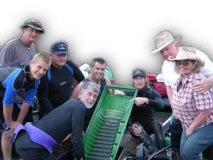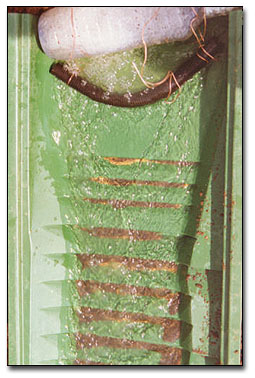
By Dave McCracken
Using the Le Trap Sluice to make your
final clean-up go faster.

Because we have so many innovative, active gold dredgers and small-scale miners on the Klamath River, I don’t recall exactly who came up with the original idea of using a Le’ Trap sluice for final cleanup. When I first heard of it, I had reservations. We have been improving the fine gold recovery on our dredges for years. I was afraid the plastic sluice in final cleanup would lose a large percentage of the extra-fine gold that we are now recovering in our dredges. However, upon close inspection, this proved not to be the case.
One of the most time consuming jobs on any serious gold dredging activity is the final cleanup procedure of separating your gold from all of the other heavy black sands and materials which are also recovered by the dredge. My personal operation is utilizing two eight-inch dredges. We are working in an extensive fine-gold paystreak, which requires us to cleanup about two-thirds of our recovery systems at the end of each day. This amounts to about three five-gallon buckets of concentrates to process. In the past, we have utilized spiral wheels and just about every other kind of cleanup device available to process our final concentrates down to our final gold product. Always, with any of these devises, we succeeded in reducing the amount of concentrates down to about a handful, which we would then process with mercury amalgamation.
During the last several years, we have been using a professional shaker table to work our concentrates down. We found that the shaker table was faster than spiral wheels and the other devises we had tried. Even so, with three five-gallon buckets to process, we were spending several hours each day just running our concentrates across the table. Once the concentrates are worked down to a handful-sized amount, the final amalgamation process only takes about a half hour. In other words, the most time consuming job had been to work the concentrates down to just a small amount.
Shortly after we heard that the Le’ Trap sluice was being successfully used, there were other dredgers on the Klamath, dredgers who knew what they were talking about, starting to rave about how fast and effective the sluice was for final cleanup. Lots of people were starting to use the new system. Consequently, we decided to give it a try. We were quite impressed with the results!
Basically, the system is quite easy, and also quite inexpensive. The Le’ Trap sluice retails at about $90. When used in conjunction with a dredge, no further equipment or pumps, etc., are needed, except a garden trowel of some kind to shovel concentrates with.
We start our dredge and run it just over idle speed to get a small amount of water moving through the primary dredge sluicebox. Water flow through the Le’ Trap sluice can be adjusted by engine speed, or by placing any flat objects under the tail end of the sluice. If you do not have enough water flow, you will notice the black sand does not move through the sluice with any regularity. Rather, it tends to pack up and bury the riffles. In this case, you will notice your gold sitting on top of the black sand, rather than inside the riffles.
If you have too much water flow, you will notice that the black sand flies through the box, with little chance to make contact with the riffles. There is plenty of margin for error. Ideally, with the proper water flow, as you feed concentrates into the sluice with a garden trowel, you will watch the black sands work their way down the box in an orderly procession. The flat, smooth section of the box ahead of the riffles allows the pieces of gold to trail along just behind the black sands. And the riffles stay somewhat clean and open. You can watch the flakes of gold wash down and drop into them.
When done properly, you will find 90% of your gold trapped behind the first four or five riffles. A few pieces, just a few, will work their way further down. But, almost none make it all the way out of the Le’ Trap sluice. We were working with several ounces of very fine gold per day; and to test the system, several times we brought all of the tailings home to see what we had lost from the Le’ Trap Sluice. It was never more than a half of one percent of our total gold recovery.
Sluice. It was never more than a half of one percent of our total gold recovery.
And, really, we didn’t even lose that gold, because it simply ran back into our dredge recovery system.
The Le’ Trap sluice is a one-piece molded unit which has a unique set of very efficient short riffles which seem to suck the gold right out of the water’s current. Cleanup of the sluice is simply a matter of tilting it up and dumping it into a tub or gold pan. The final product ends up not being much more than a handful of gold and your heaviest concentrates. Needless to say, this is much easier to deal with, rather than having to lug several heavy buckets of concentrates up the hill to our vehicles!
The main ingredient that we saved with this new cleanup system is time. We were able to feed the Le’ Trap sluice about twice as fast as our commercial shaker table. And, we only needed to screen the concentrates down through a quarter-inch screen using the Le’ Trap sluice, rather than through a quarter-inch mesh screen, then an eighth-inch screen, and then a 20 mesh screen to use the shaker table. This saved a lot of time in itself.
Plus, the system was so simple to use, we purchased a second sluice and used one on each dredge to cut our cleanup time in half again!
Since it only takes one person to feed the Le’ Trap sluice, we would put everyone else to work with end-of-the-day organizational activities while the concentrates were being run. Things like putting airlines and weight belts away, transferring used gas cans off the dredges, minor equipment repairs, etc. About the time that everything is put away and finished for the day, the concentrates are also finished, and we only have a half-hour of finish-up when we get home. This is a HUGE improvement over our old systems for final cleanup.
While smaller dredges have lesser amounts of concentrates to deal with at the end of the day, the time it takes to work them down usually is considerable, even on a three-inch dredge operation. That is, providing you are recovering worthwhile amounts of gold, especially fine gold. I don’t see any reason why the Le’ Trap sluice could not benefit any dredging operation where the dredge sluice is wide enough to allow the Le’ Trap box to fit inside.
We will be using this system in our operations during this upcoming season, and in future seasons until someone comes up with something better and faster. Anyone want to buy a good commercial shaker table?





